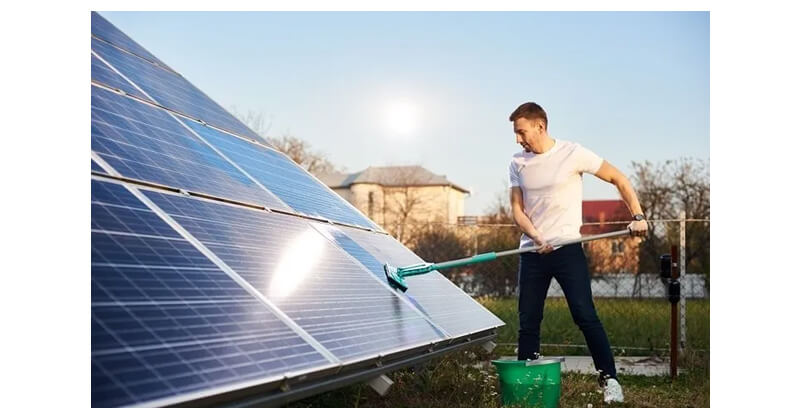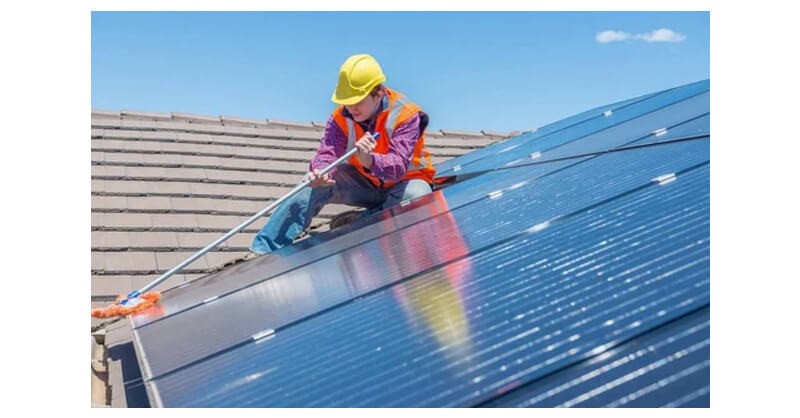Contents:
Solar energy has become a popular and sustainable choice for Australian households and businesses. With a strong emphasis on renewable energy, solar panels have become a significant investment for those seeking to reduce energy costs and minimize their carbon footprint. However, to maximize efficiency and longevity, solar panels require regular maintenance—specifically, cleaning. Dust, bird droppings, pollen, and other debris can accumulate on solar panels and reduce their performance.
One of the best ways to keep your solar panels clean is by using a specialized solar panel cleaning brush. In this guide, we’ll explore the best options for solar panel cleaning brushes in Australia, factors to consider when choosing the right tool, and how to maintain your panels properly.

Solar panels work by absorbing sunlight and converting it into electricity. However, when dirt or debris accumulates on the surface, it can block sunlight, leading to a decrease in energy production. According to research, even a thin layer of dust can reduce a solar panel’s efficiency by up to 20%. In regions like Australia, where dust storms and harsh weather conditions are common, regular cleaning becomes even more essential to maintain optimal performance.
When selecting a solar panel cleaning brush, several key factors should guide your decision:
- Soft Bristles: The bristles should be soft enough not to scratch or damage the delicate surface of the panels.
- Extendable Handle: Since most solar panels are installed on rooftops, a brush with an extendable handle will allow you to reach all areas without climbing or straining.
- Water Flow System: Some cleaning brushes come equipped with a water flow system, allowing you to connect them to a hose for easy rinsing as you clean.
- Durability: The materials used in the brush should withstand the harsh Australian climate, including intense UV exposure and frequent use.
- Compatibility with Cleaning Solutions: Make sure the brush is compatible with any solar panel cleaning solutions you might use to avoid chemical reactions that could damage the panels.
Based on customer reviews and expert recommendations, here are the top solar panel cleaning brushes available in Australia:
| Brand |
Features |
Price |
Pros |
Cons |
| Neexgent Solar Brush |
Soft bristles, extendable handle, water flow system |
AUD 59.99 |
Durable, lightweight, and easy to use |
No additional cleaning heads included |
| Sun Brush Pro |
Soft bristles, adjustable angles, hose attachment |
AUD 85.00 |
Excellent reach, durable material |
Slightly heavy when extended |
| EcoFlow Solar Cleaner |
Microfiber head, telescopic handle, water-fed brush option |
AUD 72.50 |
Suitable for larger solar arrays, eco-friendly |
Pricey for basic models |
| Solar Panel Pro Broom |
Soft silicone bristles, easy water attachment, lightweight |
AUD 64.99 |
Non-abrasive bristles, excellent for frequent use |
May need extra care to avoid kinking in water hose |
| SunPowa Cleaning Brush |
Soft nylon bristles, water supply connection, durable build |
AUD 79.99 |
Good water flow system, easy to assemble |
Bulkier than other models |
Cleaning your solar panels is straightforward with the right tools. Follow these steps for optimal results:
- Turn Off the Solar System: Always ensure the solar system is turned off before cleaning to avoid any electrical risks.
- Rinse the Panels: Start by rinsing the panels with water to remove loose dirt and debris.
- Apply a Cleaning Solution: Use a solar panel-friendly cleaning solution and gently scrub with your brush. Avoid harsh chemicals or abrasive cleaning materials.
- Scrub with the Brush: Use long, smooth strokes, starting from the top of the panel and working your way down. This allows the dirty water to flow off the panel naturally.
- Rinse Again: After scrubbing, rinse the panels again with water to remove any remaining dirt or soap residue.
- Dry the Panels: If needed, use a soft microfiber cloth to wipe away excess water, although many brushes will minimize water retention.
For further detailed guidance, check out this helpful article on how to clean solar panels in Australia: How to Clean Solar Panels in Australia.
The frequency of cleaning solar panels depends on various factors, such as the environment, weather conditions, and local wildlife activity. In dry and dusty areas or coastal regions where salt can accumulate, solar panels may need cleaning more often, perhaps every three to six months. In less dusty environments, an annual cleaning may suffice. Regular inspections will help determine when cleaning is necessary.
While using a solar panel cleaning brush is a simple and effective DIY method, there are situations where professional services might be more beneficial. Professionals have access to specialized equipment, experience in safely working on roofs, and knowledge of solar systems to prevent accidental damage. In cases where the panels are installed on multi-story buildings or hard-to-reach locations, hiring professionals may be a safer and more efficient option.
One often overlooked aspect of solar panel maintenance is the environmental impact of cleaning. Many cleaning solutions contain harmful chemicals that could damage the local ecosystem, especially when cleaning large solar farms. Opt for eco-friendly cleaning products or simply use filtered water with your solar panel cleaning brush. Additionally, excessive water use can be a concern in areas prone to drought, so water-saving brushes with controlled flow systems are ideal.
For businesses and large-scale solar farms, maintaining solar panels is crucial to ensuring uninterrupted energy production. Large installations often require more frequent cleaning due to the sheer number of panels involved. Additionally, commercial installations might benefit from automated solar panel cleaning systems that can be programmed to clean panels at regular intervals without manual labor.

Australia’s unique weather patterns can directly impact the cleanliness and efficiency of solar panels. In rural areas, dust storms are common, while coastal regions face salt build-up from sea spray. Rain can sometimes clean panels, but heavy storms often leave behind mud and grime that needs to be cleaned manually. Cleaning solar panels before the rainy season or after a storm ensures maximum sunlight exposure.
-
Monitor Weather Conditions: Australia’s weather can be unpredictable, so schedule cleaning on days when it’s calm and cool. Avoid cleaning during midday when the sun is at its peak.
- Clean Regularly: Set a schedule for cleaning, especially if you live in a region prone to dust storms, bird activity, or high pollen counts.
- Inspect for Damage: While cleaning, inspect your panels for any signs of wear or damage, such as cracks or loose wiring. Addressing these issues promptly can prevent costly repairs in the future.
- Use Filtered Water: If possible, use filtered or distilled water to prevent mineral deposits or streaks from forming on the panels.
- Consider Professional Help: If you are unsure about cleaning your panels or if they are installed in hard-to-reach areas, it might be worth hiring a professional cleaner.
FAQs







